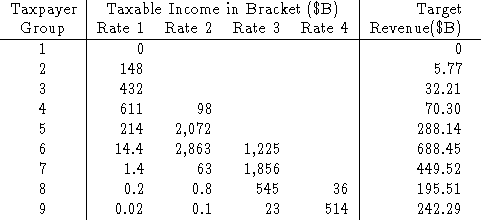The U.S. Treasury's Office of Tax Analysis (OTA) has as its functions
the evaluation of proposed changes to the federal tax law and the
creation of tax-law proposals to support the President's policies. OTA
is often requested to design a marginal-income-tax-rate structure that
will yield a particular distribution of tax liability. The problem is
characterized by the division of the tax-paying population into groups,
usually on the basis of income. For each group of taxpayers, a target
aggregate tax liability is specified and the tax schedule is designed to
achieve this.
Tax Rate Schedules
The U.S. individual income tax code uses a marginal tax rate
schedule. Each person's income is divided into brackets to which
different rates are applied. In a ``four-bracket" hypothetical example,
the first $10,000 earned is not taxed (the so-called ``zero-bracket"),
the next $8,000 (all dollars earned above $10,000 but ![]() $18,000)
is taxed at rate
$18,000)
is taxed at rate ![]() , the next $20,000 earned (between $18,000 and
$38,000) is taxed at rate
, the next $20,000 earned (between $18,000 and
$38,000) is taxed at rate ![]() , the next $30,000 (between $38,000
and $68,000) is taxed at rate
, the next $30,000 (between $38,000
and $68,000) is taxed at rate ![]() , and all income above $68,000 is
taxed at rate
, and all income above $68,000 is
taxed at rate ![]() . Hence an individual making $25,000 will pay
. Hence an individual making $25,000 will pay
![]() in taxes, while someone earning $100,000 will pay
taxes of
in taxes, while someone earning $100,000 will pay
taxes of ![]() .
.
Designing Tax Rate Schedules
The OTA is often given the job of identifying a tax schedule that will
generate desired amounts of revenue for the government from different
taxpayer groups. For example, Table 9 shows the total
taxable income within four brackets by nine taxpayer groups. For
example, all of the individuals in taxpayer group 5 are projected to
earn $214B in income from bracket 1 and $2,072B of taxable income in
bracket 2. The revenue generated (taxes assessed for government
spending) from these people is ![]() billion dollars.
billion dollars.
Policy makers have set revenue targets for each taxpaying group. For example, for group 5 in Table 9, it is desired that the $28,814B in revenues be acquired.

Table 9: Four-bracket Tax Schedule Aggregates and
Targets
Assignment
Using the data from Table 9 build and solve GAMS models for the following assignments.